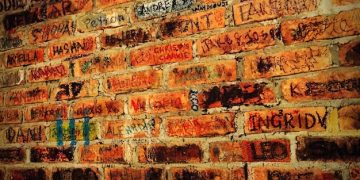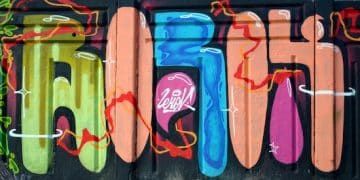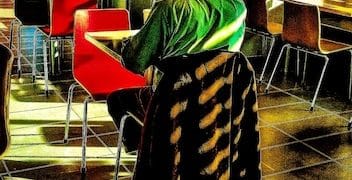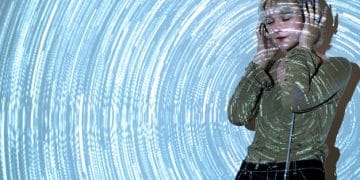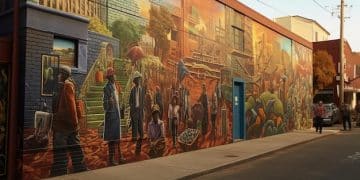AI Music Tools & Underground Authenticity in 2025: A Deep Dive
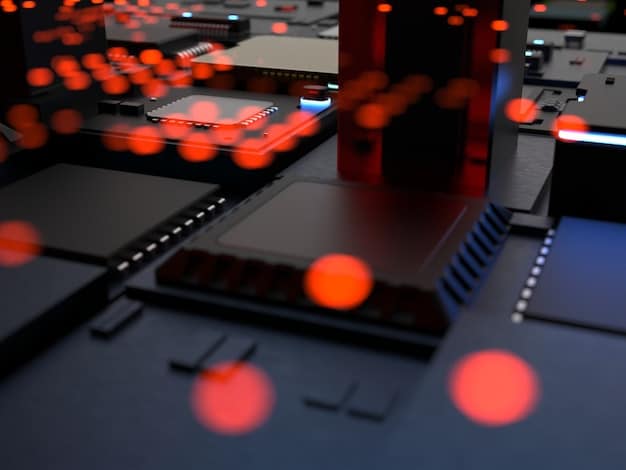
The emergence of AI-powered music creation tools by 2025 is poised to significantly challenge the traditional notions of authenticity within underground music scenes, potentially redefining creativity, intellectual property, and community dynamics.
The dawn of 2025 brings with it a burgeoning question for artists, producers, and connoisseurs alike: How will AI-powered music creation tools impact underground music authenticity in 2025? As artificial intelligence continues its rapid evolution, its integration into the artistic process is no longer a futuristic fantasy but a present reality. For underground music, a realm often defined by raw expression, rebellion against the mainstream, and a fiercely independent spirit, this technological shift poses both intriguing possibilities and profound dilemmas regarding its core authenticity.
The Rise of AI in Music Production
The landscape of music creation is undergoing a radical transformation, fueled by the accelerating capabilities of artificial intelligence. Once confined to theoretical discussions or highly specialized academic labs, AI-powered tools are now accessible to a much broader audience, including independent and underground artists. These tools promise to redefine what’s possible in the studio, from generating complex melodies and harmonies to automating mixing and mastering processes.
This technological surge is not merely about efficiency; it’s about expanding creative horizons. AI algorithms can analyze vast datasets of existing music, learning patterns, structures, and stylistic nuances that might take a human lifetime to master. They can then apply this knowledge to generate new musical ideas, suggest variations, or even compose entire pieces with minimal human intervention. For the underground artist, this could mean bypassing traditional limitations of budget, time, or technical skill, allowing a singular vision to manifest with unprecedented ease.
Evolution of AI Capabilities
The journey of AI in music has been a gradual but persistent climb. Early attempts were often rudimentary, producing mechanical or emotionless compositions. However, advances in machine learning, particularly deep learning and generative adversarial networks (GANs), have led to significantly more sophisticated and artistically compelling results. These newer algorithms can grasp intricate musical concepts, understand emotional arcs, and even mimic specific artistic styles with remarkable accuracy. This refinement means AI is moving beyond mere utility, stepping into a role that could be described as a creative partner.
Accessibility and Democratization
Perhaps one of the most significant impacts of AI on music is its potential to democratize creation. Historically, producing high-quality music required expensive equipment, specialized training, and often, access to professional studios. AI tools, often available as software plugins or cloud-based platforms, significantly lower these barriers to entry. This increased accessibility can empower countless aspiring artists in the underground scene who previously faced insurmountable hurdles. It levels the playing field, allowing talent and originality to shine, regardless of financial background or geographical location.
* Affordable software solutions
* Reduced need for extensive technical knowledge
* Ability to prototype ideas rapidly
* Access to diverse sonic palettes
The democratization enabled by AI tools could lead to an explosion of new sounds and genres emerging from previously underserved communities. This broadens the creative pool and injects fresh perspectives into the underground, potentially fostering a richer and more diverse musical ecosystem. However, this accessibility also raises questions about saturation and the very definition of a “unique” sound.
The integration of AI into music production is an undeniable trajectory. As these tools become more intuitive and powerful, their presence in the underground will only deepen, forcing a re-evaluation of how music is made, perceived, and valued. The implications for authenticity, a cornerstone of underground ethos, remain a central point of contemplation.
Defining Authenticity in the Underground Music Scene
Authenticity is a multifaceted concept, particularly within the dynamic and often defiant world of underground music. It’s not a singular, easily quantifiable trait but rather a confluence of factors that contribute to a collective perception of genuineness and integrity. For many, authenticity defines the very essence of underground music, setting it apart from the perceived homogeneity and commercialism of the mainstream.
At its core, authenticity in underground music often revolves around a sense of “realness” – a feeling that the music is a direct, unvarnished expression of the artist’s identity, experiences, and artistic vision. It implies a resistance to compromise for commercial gain, a commitment to artistic integrity, and a connection to a specific subculture or community. This often manifests in raw, unpolished sounds, unconventional structures, and lyrical themes that challenge societal norms or explore niche interests.
Core Tenets of Underground Authenticity
Several key elements typically underpin the notion of authenticity in underground music. One crucial aspect is the DIY (Do It Yourself) ethos. This means artists are often involved in every stage of their music creation, from writing and recording to mixing, mastering, and even self-distribution. This hands-on approach reinforces the idea that the music is a direct product of the artist’s personal effort and vision, untainted by external industry pressures. It signifies independence and a rejection of corporate pipelines.
Another vital component is artistic integrity. This refers to the artist’s unwavering commitment to their unique creative path, even if it means sacrificing mainstream appeal or financial success. It’s about staying true to one’s artistic voice and not bending to trends or commercial demands. This often leads to experimental sounds, challenging lyrical content, and a disregard for conventional song structures.
The connection to community is also paramount. Underground scenes thrive on shared values, niche interests, and a collective sense of identity among artists and fans. Authenticity is often bolstered by an artist’s perceived dedication to their local scene, their participation in community events, and their alignment with the broader cultural movements that define their genre. This community aspect fosters a sense of belonging and validates the music’s purpose beyond mere entertainment.
The Role of Human Touch and Emotion
Perhaps the most intangible yet critical aspect of authenticity is the presence of a “human touch” and genuine emotion. Listeners often seek out music that resonates on a personal level, that feels raw, vulnerable, or passionately expressed. Imperfections, spontaneous choices, and the unique sonic fingerprint of a human performer are often celebrated as marks of authenticity. The belief is that true art stems from human experience, struggle, and triumph, and these cannot be fully replicated.
* Rawness and imperfection
* Emotional depth and vulnerability
* Personal narratives and experiences
* Spontaneity and improvisation
When a listener encounters underground music, they often look for a story, a connection to the artist’s soul. The authenticity lies in the belief that what they are hearing is a genuine outpouring of creativity, unmediated by algorithms or corporate interests. The challenge for AI-powered tools, therefore, is not just to produce technically proficient music, but to replicate or even enhance this elusive human quality that is so highly prized in the underground. The question then becomes, can a machine truly possess or convey authenticity?
Challenges to Authenticity with AI Tools
The integration of AI-powered music creation tools into the underground scene, while offering unprecedented creative avenues, also presents significant challenges to the established notions of authenticity. As algorithms become more sophisticated, the line between human and machine creativity blurs, prompting complex questions about artistic ownership, originality, and the very soul of music.
One of the primary concerns revolves around the concept of originality. If an AI can generate a melody, a chord progression, or even an entire track based on learned patterns from existing music, can that output truly be considered original? Underground music prides itself on innovation and pushing boundaries, and the fear is that AI might lead to a homogenizing effect, where new music merely remixes or reinterprets existing styles, rather than forging genuinely novel paths. An AI can learn to sound like “Pixies meets Sonic Youth,” but can it truly conceive of a sound that never existed before?
The “Human Touch” Dilemma
The debate inevitably returns to the “human touch.” Many argue that the raw, imperfect, and often vulnerable nature of human creation is what imbues underground music with its authenticity. The serendipitous mistakes, the emotional intent behind a vocal performance, or the unique feel of a drummer’s groove are often seen as irreplaceable. AI, by its very nature, operates on logic and algorithms. While it can simulate emotion and human-like performance, it lacks lived experience and genuine feeling. This raises the question: can music devoid of human emotion truly be authentic in the context of the underground, where emotional resonance is so highly valued?
Intellectual Property and Ownership
A pressing legal and ethical challenge relates to intellectual property. If an AI generates a track, who owns the copyright? Is it the programmer of the AI, the artist who provided input, or the AI itself? Given that AI learns from vast databases of existing music, the potential for inadvertent plagiarism or indirect appropriation of artists’ styles becomes a major concern. For underground artists who often guard their unique sounds fiercely, this ambiguity around ownership could lead to significant disputes and devalue their creative output. The concept of “intellectual lineage” becomes incredibly complex when an AI is involved.
These challenges highlight a critical ongoing discussion within the underground music community. The debate is not necessarily about rejecting technology outright, but about how to wield these powerful tools in a way that respects and preserves the authentic spirit of artistic creation. Navigating these complexities will be crucial for the continued evolution and integrity of underground music in 2025 and beyond.
Opportunities for Enhanced Authenticity
While AI-powered music creation tools present undeniable challenges to traditional notions of authenticity in the underground scene, they also unlock a myriad of opportunities to actually enhance and redefine it. Far from being a destructive force, AI can serve as a catalyst for deeper creative exploration, empowering artists in unprecedented ways and fostering new forms of genuine expression.
One of the most compelling opportunities lies in amplifying unique artistic visions. For many underground artists, the struggle lies in translating complex sonic ideas into reality due to technical limitations or resource constraints. AI can act as an extension of the artist’s mind, helping to overcome these hurdles. Imagine an artist with a groundbreaking concept but limited instrumental proficiency; AI can facilitate the realization of that concept, allowing the authentic vision to emerge unhindered by technical skill gaps. This means more artists can produce exactly what they hear in their heads, leading to a richer and more varied soundscape.
Unlocking New Sonic Landscapes
AI’s ability to process and generate novel sounds opens doors to entirely new sonic landscapes. By venturing beyond conventional musical structures and timbres, artists can create something truly unprecedented. This is not about replicating existing genres but about inventing new ones. An AI might suggest unusual harmonic progressions, unexpected rhythmic patterns, or synthesize utterly alien soundscapes that a human might not conceive through traditional means. This pushing of creative boundaries can lead to a fresh authenticity – an authenticity of true innovation and artistic pioneering.
* Generation of unique melodic lines
* Experimentation with unconventional rhythms
* Creation of custom, never-before-heard sounds
* Exploration of microtonal or non-Western scales
These breakthroughs allow artists to break free from established norms, fostering a kind of authenticity that stems from radical originality rather than adherence to traditional forms. The “unknown” becomes a canvas.
Empowering the DIY Ethos
Ironically, AI tools can further empower the DIY ethos central to underground music. By automating repetitive or technically demanding tasks like advanced mixing, mastering, or even certain compositional elements, AI frees up artists to focus more on the core creative aspects: songwriting, conceptualization, and emotional expression. This allows a single artist or a small collective to achieve production quality previously requiring a full studio and team, making truly independent and self-sufficient creation more attainable than ever. The artist retains maximum control, reinforcing their genuine artistic vision from start to finish.
The enhanced accessibility of high-quality creation tools also means more voices can enter the scene. This diversification can bring new perspectives, cultural influences, and experimental approaches that enrich the very fabric of underground music. Authenticity in this context evolves to mean the genuine output of a wider array of unique individual artistic voices, rather than a select few with access to traditional resources. The conversation shifts from “is it human-made?” to “does it truly express the artist’s unique voice, regardless of the tools used?”
Ultimately, the impact of AI on authenticity will be shaped by how artists choose to use these tools. When harnessed as creative partners and amplifiers of unique visions, rather than mere substitutes for human ingenuity, AI has the potential to foster a new, perhaps even more profound, form of authenticity within the vibrant universe of underground music.
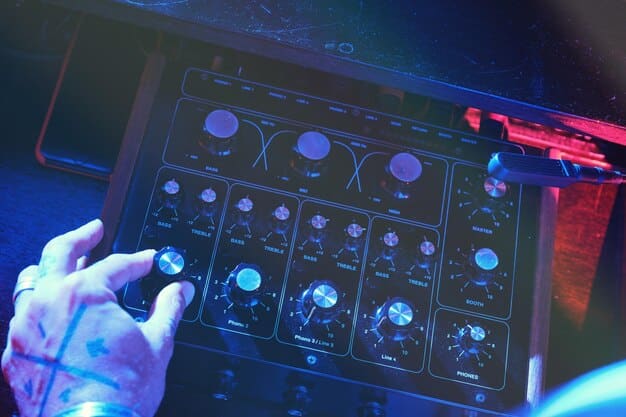
Shifting Paradigms: Human-AI Collaboration
The future of music creation within the underground scene, particularly concerning authenticity, is likely to be defined by a significant paradigm shift towards human-AI collaboration rather than pure human or machine creation. This synergistic approach recognizes the unique strengths of both human intuition and algorithmic power, forging a new frontier for artistic expression where authenticity isnity not diminished, but reimagined.
In this collaborative model, AI is not seen as a replacement for the artist but as a sophisticated tool or an “intelligent assistant.” The artist retains ultimate creative control and direction, using AI to augment their abilities, explore new ideas, and streamline parts of the production process. This partnership allows artists to focus on the higher-level conceptual and emotional aspects of their music, delegating repetitive or data-heavy tasks to AI, thereby potentially accelerating their creative output and allowing for more thorough experimentation.
AI as a Creative Catalyst
AI can act as an invaluable creative catalyst. For instance, an artist struggling with writer’s block might use an AI to generate novel melodic variations based on a short motif or explore complex rhythmic patterns that would be daunting to program manually. This spontaneous generation of ideas can spark new directions, pushing the artist beyond their habitual creative comfort zones. The AI offers possibilities, but the artist makes the discerning choices, curating the AI’s output and imbuing it with their unique sensibility and emotional context. The authenticity here comes from the human’s selective and informed decision-making process.
Streamlining Production and Enhancing Quality
Beyond pure creation, AI excels at optimizing the more technical aspects of music production. Advanced AI tools can analyze tracks for optimal mixing levels, suggest mastering adjustments, or even identify and suggest corrections for imperfect vocal takes. This efficiency allows underground artists, often working with limited resources, to achieve a polished sound that rivals commercial productions, without sacrificing their independent spirit. The authenticity is preserved because the core creative vision remains human, while the technical execution is simply refined.
The human element remains paramount in this collaborative vision. It’s the human artist who conceives the initial idea, guides the AI’s output, infuses the music with emotional intent, and ultimately determines what constitutes a finished piece. The AI provides the palette of possibilities, but the artist paints the picture. This process underscores a new definition of authenticity: one that recognizes the clever deployment of technology in service of a genuine, human-driven artistic vision. As 2025 progresses, the most impactful underground music might very well be found at the intersection of human creativity and AI innovation, blurring lines in fascinating and artistic ways.
Ethical Considerations and Community Response
As AI-powered music creation tools become more prevalent, the underground music scene is forced to grapple with a complex array of ethical considerations and navigate a varied community response. These factors will undoubtedly shape how authenticity is perceived and defended in 2025, influencing the very social fabric of independent music.
A significant ethical concern revolves around the concept of fair compensation and attribution for artists whose work is used to train AI models. If an AI learns from thousands of existing tracks, including those of underground artists, how does that translate into fair compensation if the AI then generates new music that bears a resemblance to their style? Without clear frameworks, there’s a risk that AI developers might profit from artists’ creative labor without proper remuneration or even acknowledgment, undermining the very basis of artistic enterprise. This issue is particularly poignant for underground musicians who often struggle financially and depend on direct acknowledgement and support.
The Debate on “Soul” and Originality
Within the community itself, there’s a fervent debate about the “soul” of music created with AI. Many purists argue that true art must come from a living, breathing, feeling being, and that AI-generated music, no matter how technically proficient, lacks the human essence that makes music profound. This perspective often clashes with those who view AI as just another tool, like a synthesizer or a drum machine, capable of extending human creativity. The tension lies in reconciling the emotional, human-centric definition of authenticity with the technological prowess of AI. This ongoing dialogue shapes listener perception and the perceived legitimacy of AI-assisted art.
Potential for Displacement and Devaluation
Another worry within the underground is the potential for AI to displace human artists or devalue established human-made music. If AI can produce high-quality tracks quickly and cheaply, will it become harder for human artists to gain recognition, particularly those emerging from independent scenes? There’s a fear of a “race to the bottom” where the sheer volume of AI-generated content overwhelms human output, making it difficult for listeners to discern, appreciate, and financially support genuinely human-driven projects. This could impact the livelihood of countless underground musicians.
* Concerns over job displacement for musicians and producers
* Risk of market oversaturation with AI-generated content
* Difficulty for listeners to distinguish human vs. AI creation
* Challenges in identifying and supporting original human talent
The response from the underground community is not monolithic. While some embrace AI as a liberating force, others view it with caution or outright skepticism. This internal dialogue is crucial, as it forces the scene to define its values and boundaries continually. Navigating these ethical dilemmas and fostering a robust discussion will be key to ensuring that AI integration aligns with, rather than detracts from, the authentic spirit of underground music in 2025. This collective processing of the technology’s implications will define the future contours of authenticity.
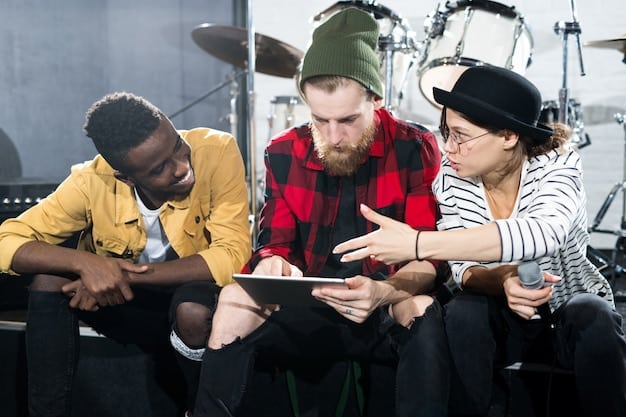
Looking Ahead: Authenticity’s Evolution in 2026 and Beyond
As we look beyond 2025, the trajectory of AI in music suggests that the concept of authenticity within the underground scene will not remain static; rather, it will evolve. This evolution won’t necessarily mean discarding traditional values, but rather adapting them to encompass new realities shaped by technology. The debate will shift from whether AI can be authentic to how authenticity manifests in an increasingly human-AI collaborative landscape.
One significant shift will likely be a greater emphasis on the artist’s intent and curation. In a world where AI can effortlessly generate highly polished sounds, the true mark of authenticity might lie not in the absence of AI, but in the deliberate and considered choices an artist makes in conjunction with AI. The artist’s distinctive vision, their ability to guide and refine AI outputs into something truly unique and emotionally resonant, will become the determinant of authenticity. It’s less about whether a sound was generated by AI and more about the human intelligence and artistry behind its final presentation.
Value in Storytelling and Narrative
The value placed on storytelling and narrative will likely deepen. As the technical proficiency of music becomes more democratized by AI, the unique human stories, experiences, and social commentary embedded within underground music will become even more precious. Listeners will seek out narratives that connect with them on a deeper, more personal level, appreciating the human vulnerability and perspective that AI cannot replicate. Authenticity will be tied to the courage to share a genuine human experience through sound, regardless of the tools used in its creation.
Reimagining “Liveness” and Performance
The concept of “live” performance might also undergo redefinition. While the energy of a human-only band on stage remains irreplaceable for many, AI could enable new forms of immersive and interactive live experiences. Artists might perform alongside AI-generated visuals or manipulate AI-generated soundscapes in real-time, creating performances that are both technologically advanced and deeply expressive. The authenticity will depend on the real-time human interaction with the technology, and the spontaneity it allows, rather than a pre-programmed, static show. This brings a fresh layer to engagement and artistic output.
The underground scene, with its history of embracing unconventional methods and challenging norms, is uniquely positioned to lead this redefinition. Its inherent adaptability and quest for genuine expression will guide how AI is integrated. While purists may long for a past unburdened by algorithms, the pragmatic reality is that AI tools are here to stay. The question for 2026 and beyond is not how to avoid them, but how to master them in a way that amplifies the very authenticity the underground holds dear. The future of authenticity in underground music will be a testament to human ingenuity’s ability to transcend its tools, leaving its indelible emotional mark on every note.
| Key Point | Brief Description |
|---|---|
| 🤖 AI Integration | AI tools are becoming ubiquitous, aiding underground artists with composition, mixing, and mastering, increasing accessibility. |
| ✨ Authenticity Redefined | Traditional notions of authenticity (DIY, human touch) face challenges but can evolve through human-AI collaboration. |
| 🤝 Human-AI Synergy | AI as a catalyst for new ideas and production efficiency, with human artists retaining creative control and intent. |
| ⚖️ Ethical Landscape | Concerns about intellectual property, fair usage, and the “soul” of AI-generated music will shape community response. |
Frequently Asked Questions
▼
By 2025, AI is unlikely to fully replace human artists in underground music. Instead, it’s expected to become a powerful tool for augmentation, assisting artists in generating ideas, refining sounds, and streamlining production. The human element of unique vision and emotional expression will remain crucial for authenticity and connection within the scene.
▼
Underground artists can maintain authenticity by using AI as a creative assistant, not a replacement. Authenticity will increasingly stem from the artist’s unique curation, intentional choices, and their ability to infuse AI-generated elements with personal narrative and emotional depth. The human artistic vision will remain the guiding force.
▼
Key ethical concerns include intellectual property rights, fair compensation for artists whose work trains AI models, and the potential for AI to devalue human creative output. The debate surrounding the “soul” of AI-generated music and its impact on originality also features prominently in community discussions.
▼
While a risk of homogenization exists if AI is used uncritically, it can also foster greater diversity. AI’s ability to generate novel sounds and aid in experimental composition means artists can explore new genres and palettes, potentially leading to a broader array of unique sounds within the underground, expanding rather than limiting creativity.
▼
Listener perception will likely evolve. While some may initially be skeptical, increasing familiarity with AI’s role could lead to an acceptance where authenticity is defined by the artist’s imaginative use of technology to express unique human experiences. The focus will shift to the intentionality and emotional impact of the final product.
Conclusion
The integration of AI-powered music creation tools into the underground scene by 2025 represents more than a technological shift; it marks a profound moment of introspection for the very definition of authenticity. While the challenges regarding originality, human touch, and intellectual property are undeniable, they are equally matched by opportunities for enhanced creativity, greater accessibility, and the emergence of entirely new sonic frontiers. Ultimately, the impact on authenticity will hinge on human agency – how artists choose to harness these tools, how communities adapt their values, and how listeners recalibrate their perceptions. The underground, with its inherent adaptability and continuous quest for genuine expression, is uniquely positioned not just to survive this shift, but to lead the way in crafting a new, technologically informed, yet deeply human, narrative of musical authenticity.
